Latest News
January 1, 2009
By Al Dean
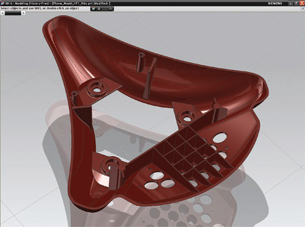 The Design Freedom capability in NX6 enabled by Synchronous Technology makes modeling changes a snap, like moving the attachment bosses on this conference phone design. |
Siemens PLM Software’s latest release of NX predictably incorporates the company’s Synchronous Technology. What was not so easily predicted is that the combination in NX6 results in a much more dynamic way of creating, editing, and interacting with geometry.
Synchronous Technology (ST), as you remember, enables the user to work with geometry history free, retaining feature information and allowing you to work with your part’s form on the fly — no recalculation required. On top of this, you have the ability to define relationships between geometric features, dimensions, and other parameters without needing expert knowledge of how a part or assembly was constructed. We must note that within the context of NX, Synchronous Technology is being implemented as Design Freedom. This actually makes sense because, in comparison to Solid Edge (see DE October 2008), the way the technology has been built into NX differs greatly.
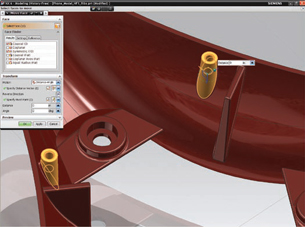 Active Selection in NX6 recognizes symmetry. By selecting one boss, the corresponding one is highlighted so both can be edited simultaneously. |
ST in the NX environment does not split your working practices. Because the last few releases (NX5 in particular) have had more direct editing tools built into NX, the system is more capable of integrating this new technology and making it usable with existing tools. Essentially, the difference is that you can flip between history and history free mode on the fly, within a part, so you can either keep a trail of everything you do in serial sequence or not.
You directly manipulate geometry and features like holes, blends, and chamfers. These features are not stored in a traditional feature history tree. As you edit, the system uses a new tool called Active Selection to find common geometry, so edits to multiple features can be made in a single operation. This allows you to edit features en masse, but with some intelligence, so that only features within your field of work are edited. This way, you won’t edit a small hole on the other side of a large part by accident.
Shells, however, do appear in a feature tree. This allows you to maintain the wall thickness as you work with the ST-based editing tools, so you can take additional geometry, paste it into your part, and then use the shell face to create and maintain the uniform thickness: your selection is the face that is integral to the part.
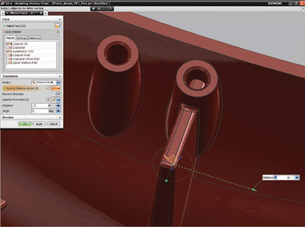 By using the drag handles, or typing a value, movement is instantly previewed and geometry is adapted to suit the new position. |
This cutting and pasting of geometry is impressive — referred to as scrapbook modeling. Whereas you might be able to use basic forms of copy-and-paste in other systems, the flexibility of ST makes this really usable. Geometric features can be cut and pasted within parts or between parts, so features that need to match at interfaces can be created quickly indeed — and they remain intelligent, so relationships are copied and moved as well. This might be subtle, but how often do you find that you are recreating the same type of geometry in different parts — even within the same part — with no real way of reusing that data on the fly? Now, you can.
This is really the crux of ST in NX. The system has never been as reliant on history based modeling processes as other systems, so developers have been able to integrate this new feature-based but history-less way of modeling into the core of the system.
User interaction
The user interface (UI) of NX over the last few releases has advanced at a phenomenal rate in terms of usability. The underlying architecture of commands and operations were completely rewritten in the last release, making them common and shared so learning times are cut. And the presentation of commands was reworked to provide a very clean interface with the majority of commands driven from the same rail-based dialog, which only shows itself when needed – this in itself boosts productivity. And when combined with the improvements to the modeling process, it means that working with the system is much more intuitive.
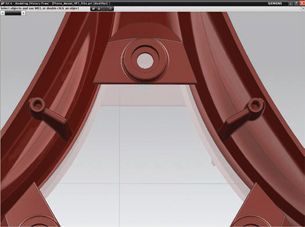 Once the move is applied, the blend automatically adapts and the hole protrudes into the rib. With ST in NX6, no rework is necessary. |
This release extends the use of “on model” working further in several areas. The radial toolbars have been greatly extended. Menus can be accessed in full (using the ALT key), multiple layers of context-sensitive commands are available at the cursor and, when combined with the new ways of working introduced with ST, you have one extremely intuitive system.
You can now switch to Full Screen mode, which with the rail-based toolbars, new at cursor menus, makes a great deal of sense and gives you a huge working area. Alongside this, the new TrueShade mode displays your geometry with realistic materials, shadows, a range of preset lighting conditions, and reflective floors, all without the need for high-end graphics.
Simulation
Alongside the UI updates and the introduction of ST, perhaps the biggest area of concentration — and likely to excite existing users — is simulation. NX has evolved from the amalgamation of the Unigraphics and I-deas products sets, alongside Siemens’ release of NX Nastran. The combination of the three means that Siemens’ development has had access to some of the world’s leading simulation technology and it’s been further integrated into NX.
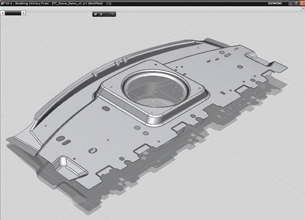 NX6 has a Reuse Library so Key Shapes can be copied from another design and used, for example, to strenghten this existing sheet metal part. This Key Shape is then dragged from the Reuse Library. |
One of the core underlying updates to simulation is the way that the various components have been restructured for reuse. When conducting simulation tasks, you now create three files, which are linked back to the originating data. The SIM file represents the loading and boundary conditions, the FEM file contains all of the work you do to clean up the model, while the POST file is where you store everything in terms of result extraction and visualization. What this means is that sections of the process are much more reusable. In addition, the new Glue Contact operation allows you to mix and match different mesh types for different sections of a single part for more real-world performance. For example, consider a toggle switch that uses deformation to lock into certain positions. Now, while some portions of the component undergo large-scale deformations, the majority do not, so why run the whole thing as a non-linear (and inherently more complex) simulation? These new tools allow you to set up the component (with materials and loading conditions) and subdivide it into sections that undergo linear and nonlinear deformation. So, the job runs as a whole and with ease, but you’re conducting what would traditionally be a very complex multiphysics simulation.
The simulation of sheet metal parts is of interest because of an increase in popularity, and NX6 introduces mid-plane modeling tools to assist in making it easier. Mid-plane modeling is a commonly used method of constructing thin-walled FEA models. When you have geometry where the mid plane is not readily apparent, gaps can occur. NX6 introduces tools that allow you to re-stitch, match, and merge edges to create a cohesive form that can be meshed. Some of the tools aren’t associative, but they get you most of the way there — assuming you don’t make massive topology changes and just need to clean things up.
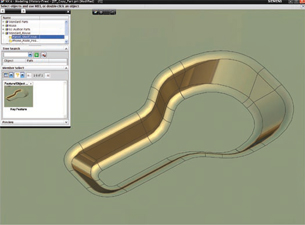 This Key Shape Feature in another component would be ideal. The designer copies it onto the clip board or, in this case, into the NX Reuse Library. This allows other users to access this too. |
Integrated 3D Search
One of the most impressive updates is the integration of Geolus technology within NX’s core. For those unaware of it, Geolus is a 3D shape search technology that Siemens PLM acquired some time ago. The core concept is that 3D shapes can be distilled into a series of vectors that describe form and geometry. Working on that basis, you can then use a number of tools to search for components that match specific search criteria. You sketch out a rough shape of the part, then use the Geolus search tools (integrated directly into the interface) to find components that are similar in terms of part numbers and classification as well as geometry.
Standard components can be located and reused quickly or you might find similar parts that can be quickly adapted to your purpose. When combined with the ease of adapting existing geometry ST brings, you should see that the combined savings in time and effort can be huge. Oh, and it works with non-NX data too, so JT data, IGES, STEP, as well as data from other systems such as CATIA and SolidWorks, can be included in the search.
We’ve barely scratched the surface of NX 6, but it should be clear that developers are continuing on an aggressive development schedule for the product and a system that’s very interesting in terms of modeling approaches. What’s interesting for me is that ST in the context of NX is much more exciting than it is in Solid Edge. I say that because NX has always enabled you to work with a wider selection of modeling methods and has always supported the ability to intelligently link part geometry to design intent on a granular level.
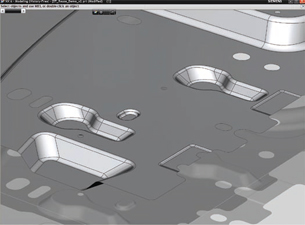 The Key Shape was added and positioned. Then the designer used Design Freedom to modify the Key Shapes by making them coplanar at one end and then extend them to add stiffness to the edge of the part. |
This is enhanced further and the system seems to be working in a more connected manner, offering better reuse capabilities and more flexible and free modeling. All this alongside, of course, the traditional parametric tools and the surface-based modeling tools that have been a mainstay of NX for years.
With the NX Nastran solver as the foundation technology, Siemens offers accessible advanced simulation tools at the design stage. Then you get into the realm of production and manufacturing. NX has always had a rock-solid reputation in machining and mold design circles, purely because it’s one of the rare systems that combined advanced CAM functionality with supremely capable modeling tools adapted to that purpose for mold and die design.
It’s clear that if you’re looking to adopt a product development and manufacturing system that really can cover everything from conceptualization to production and beyond, then NX is worthy of investigation. The introduction of Synchronous Technology means that the pains associated with learning a new design system are eased somewhat and that should drive new adoption by many. When NX is considered for its ability to capture everything that relates to intelligent product development, and that process, then it’s among the best systems currently available.
More Info:
Siemens PLM Software
Plano, TX
Contributing Editor Al Dean is the editor at DEVELOP3D, a new UK product development and manufacturing technology journal. He divides his time between daydreaming about owning a 5-axis NC machine and having nightmares explaining its purchase to his family. Send comments about this article to [email protected].
Subscribe to our FREE magazine, FREE email newsletters or both!
Latest News
About the Author
DE’s editors contribute news and new product announcements to Digital Engineering.
Press releases may be sent to them via [email protected].






